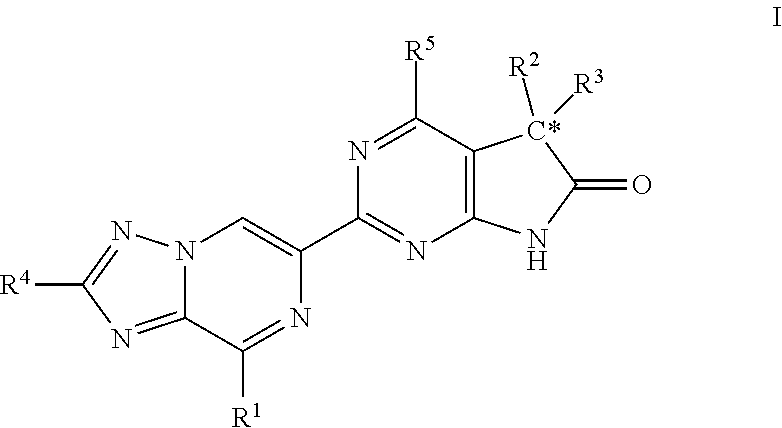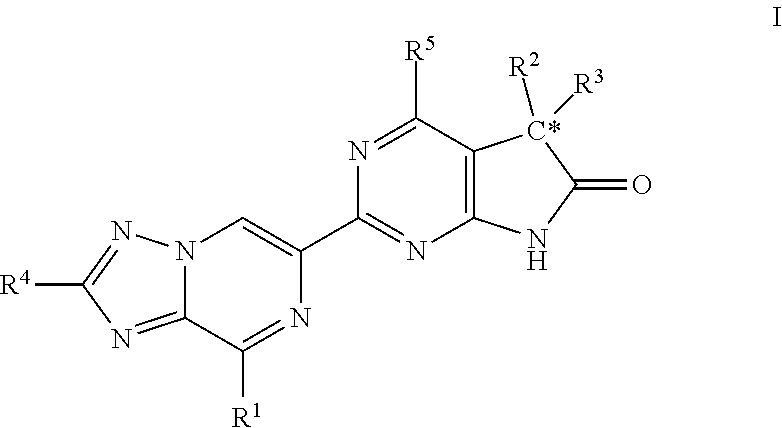Triazolo-pyrazinyl derivatives useful as soluble guanylate cyclase activators
a technology of guanylate cyclase and triazolopyrazinyl, which is applied in the direction of drug compositions, extracellular fluid disorders, metabolic disorders, etc., can solve the problems of reducing activity, reducing tolerance, and mainly only having weak effects on the formation of cgmp in cell lysates
- Summary
- Abstract
- Description
- Claims
- Application Information
AI Technical Summary
Benefits of technology
Problems solved by technology
Method used
Image
Examples
example 1a
(S)-4-Amino-5-(4-fluorophenyl)-5-methyl-2-(8-(3,3,4,4,4-pentafluorobutyl)-[1,2,4]triazolo[1,5-a]pyrazin-6-yl)-5H-pyrrolo[2,3-d]pyrimidin-6(7H)-one
[0540]
[0541]Into a vial was placed I-A2 (50 mg, 0.16 mmol), I-1A (44 mg, 0.17 mmol), potassium bicarbonate (33 mg, 0.32 mmol) and t-BuOH (2 mL). The resulting mixture was warmed at 70° C. for 16 h. The reaction was cooled to RT and quenched by the addition of brine. The resulting solution was extracted with EtOAc (3×) and the organic layers were combined, dried over anhydr. Na2SO4, filtered and the filtrate was conc. in vacuo to dryness. The residue was purified by silica gel chromatography using MeOH:DCM (10%) to afford the title product. 1H NMR (300 MHz, DMSO-d6): δ 11.26 (1H, brs), 9.44 (1H, s), 8.23 (1H, s), 7.30 (2H, dd, J=5.7, 9.0 Hz), 7.19 (2H, dd, J=9.0, 9.0 Hz), 6.66 (2H, brs), 3.55 (2H, t, J=7.8 Hz), 3.03-2.88 (2H, m), 1.80 (3H, s); m / z=523.4 (M+H).
example 2a
4-Amino-5-cyclopropyl-2-(8-(4,4,4-trifluorobutyl)-[1,2,4]triazolo[1,5-a]pyrazin-6-yl)-5-(5-(trifluoromethyl)pyridin-2-yl)-5H-pyrrolo[2,3-d]pyrimidin-6(7H)-one
[0542]
[0543]Into a vial was placed I-A1 (50 mg, 0.18 mmol), I-28A (59 mg, 0.18 mmol), potassium bicarbonate (37 mg, 0.37 mmol), and t-BuOH (3 mL). The resulting mixture was warmed at 80° C. for 16 h. The reaction was cooled to RT and conc. to remove any volatiles. The residue was purified by silica gel chromatography using MeOH:DCM (1-3%) to afford the title product. 1H NMR (300 MHz, CD3OD): δ 9.62 (1H, s), 8.92 (1H, s), 8.64 (1H, s), 8.22 (1H, dd, J=2.4, 8.4 Hz), 8.06 (1H, d, J=8.4 Hz), 3.42 (2H, t, J=7.8 Hz), 2.43-2.22 (4H, m), 2.03-1.98 (1H, m), 0.75-0.59 (4H, m); m / z=564.3 (M+H).
[0544]Using essentially the same procedures described in Examples 1 & 2, the following compounds in Table 6 were prepared.
TABLE 6ChiralMSstartingExStructureName(M + 1)material 3A4-amino-5-(5-chloropyridin-2-yl)-5- methyl-2-(8-(3,3,4,4,4-pentafluorob...
example 95b
4-Amino-5-(1-cyclopropyl-1H-1,2,3-triazol-4-yl)-5-methyl-2-(8-(3,3,4,4,4-pentafluorobutyl)-[1,2,4]triazolo[1,5-a]pyrazin-6-yl)-5H-pyrrolo[2,3-d]pyrimidin-6(7H)-one
[0545][0546]Step A—4-Amino-5-ethynyl-5-methyl-2-(8-(3,3,4,4,4-pentafluorobutyl)-[1,2,4]triazolo[1,5-a]pyrazin-6-yl)-5H-pyrrolo[2,3-d]pyrimidin-6(7H)-one: Into a vial was placed I-A2 (100 mg, 0.324 mmol), I-19B (67.9 mg, 0.357 mmol), potassium bicarbonate (39.0 mg, 0.389 mmol) and t-BuOH (5 mL). The resulting mixture was warmed at 70° C. for 16 h. The reaction was cooled to RT and quenched by the addition of brine. The resulting solution was extracted with EtOAc (3×) and the organic layers were combined, dried over anhydr. Na2SO4, filtered and the filtrate was conc. in vacuo to dryness. The residue was purified by silica gel chromatography using MeOH:DCM (10%) to afford the title product.[0547]Step B—4-amino-5-(1-cyclopropyl-1H-1,2,3-triazol-4-yl)-5-methyl-2-(8-(3,3,4,4,4-pentafluorobutyl)-[1,2,4]triazolo[1,5-a]pyrazin-6-yl...
PUM
| Property | Measurement | Unit |
|---|---|---|
| temperature | aaaaa | aaaaa |
| pressure | aaaaa | aaaaa |
| temperature | aaaaa | aaaaa |
Abstract
Description
Claims
Application Information
 Login to View More
Login to View More - R&D
- Intellectual Property
- Life Sciences
- Materials
- Tech Scout
- Unparalleled Data Quality
- Higher Quality Content
- 60% Fewer Hallucinations
Browse by: Latest US Patents, China's latest patents, Technical Efficacy Thesaurus, Application Domain, Technology Topic, Popular Technical Reports.
© 2025 PatSnap. All rights reserved.Legal|Privacy policy|Modern Slavery Act Transparency Statement|Sitemap|About US| Contact US: help@patsnap.com



